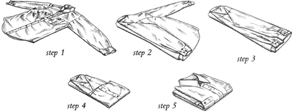
How to fold suit jackets, shirts, blouses, jackets, sweaters, T-shirts, dresses, pants and shorts, skirts, underpants, socks, napkins, tablecloths, blankets, sheets, pillowcases, towels, handkerchiefs…. How to put a duvet into a cover … Using tissue paper infolding
When I was a girl, every week my mother and I folded sheets together in a brisk dance, moving quickly and always turning the folds in the same direction. Periodically she would give the sheet a good sharp snap, which would jerk my end out of my hand if I didn’t hang on tight. Tablecloths, sheets, and other large, unwieldy items really are folded most easily by two congenial people of roughly the same height. But when I first kept house as a single woman, I learned to lay the part that would otherwise drag on the floor on a bed or sofa. I rather liked not having to worry about the other person’s suddenly giving a violent snap to her end.
Folding smaller pieces after laundering was always done by a daughter, sitting at a table. Each article was to be folded in just the right manner. Neat, separate stacks of napkins, handkerchiefs, T-shirts, towels according to their size, and piles of rolled-up sock balls, arranged according to owner, were first set on the table and left to air, if necessary, then set carefully in a basket and carried around the house to their proper storage places: linen closet, dresser drawers, or kitchen drawers.
The folding and hanging styles described in this chapter are those used in my family. Other styles might be just as good or better. But it is useful to have some habitual way of folding so as to keep things neat and wrinkle-free and to use drawer and shelf space most efficiently.
Suit Jackets. Suit jackets are hung in a closet or carried in a garment bag for traveling whenever possible. When they must be folded into a suitcase or stored flat, the following folding method works well. Put your hands into the shoulders of the unbuttoned jacket, grab the ends of the shoulder pads, and turn the shoulders inside out. Without letting go, pull the shoulders together, in the process folding the jacket inside out along the side seams. The back and sleeves now lie between the left and right front. Straighten up and align the side seams, make sure that sleeves and hems are aligned, and open the lapels. If your suitcase or drawer is large enough, you can instead simply fold the unbuttoned jacket in half lengthwise, with the lapel edges together and the side seams together.
Shirts, Blouses, Casual Jackets, Sweaters, and T-Shirts. If the shirt has buttons, button it at top, middle, and bottom. Then lay it facedown. Fold both sides of a shirt or blouse so that they meet in the back, with the sleeves aligned with the side folds. Fold the tail up to the cuffs, making a straight line at the bottom. Then fold in thirds crosswise. Casual jackets, long-sleeved sweaters, pullovers, and cardigans are folded the same way, except that there is no tail to be folded up. Do T-shirts as you do other shirts. A child’s T-shirt may need only one crosswise fold, in half; but an adult’s you may wish to fold into thirds, depending upon the size of the T-shirt and what fits comfortably in your drawer or on your shelf.

Folding a shirt

Folding a T-shirt (see “Folding a shirt” above, for steps 4 and 5)

Folding a dress
Dresses. Dresses should almost always be hung rather than folded, unless they are to go in a suitcase or other type of flat storage. To fold a dress for a suitcase, lay it front down. Fold the top as though it were a shirt or blouse. Fold the bottom hem to the knees. Then fold at the waist.
Pants and Shorts. Pants are usually hung by their cuffs on trouser hangers. Or fold them over a hanger with a thick bar or a paper guard so that a crosswise crease does not form. Shorts may be folded and placed in a drawer. Whether hung or put in a suitcase or drawer, pants and shorts are folded as follows: align the inseams and outer seams of the legs and fold so that a crease forms properly at the front center of the legs. In well-made garments, the crease should run all the way to the top of the pants, joining the front waist pleats. Fold in the front placket along the pleats.
Skirts. Lay the skirt front down, with zippers and plackets closed. Fold the sides in toward the center. Then, if it is not a short skirt, fold crosswise in thirds. The idea is to avoid a vertical crease line down the front center or a horizontal crease line halfway down the front.
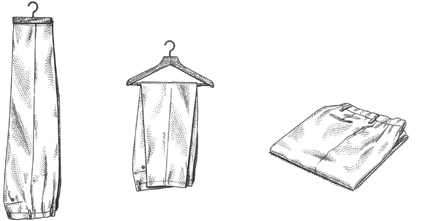
Three styles of hanging and folding slacks

Folding a skirt

Folding boxers

Folding panties
Underpants. The folding is the same for men’s and women’s. Fold in half crosswise, so that the crotch meets the waistband. Then fold into thirds. Underpants can also be laid flat, unfolded, in stacks, if they are not too large, or they can be rolled.
Socks. There are three ways to fold socks. Method 1, in which they are folded into balls, looks good and is space-efficient but tends to stretch out the top of the socks, especially all-cotton socks. In this method, you lay one sock on top of the other. Starting at the toe, roll them up together to the ribbing. Open the top of the outside sock and pull it over the roll. In method 2, the socks are simply rolled up together. This is neat and space-efficient, but the rolls can come undone and socks can separate. It’s the best method for careful adults but not for children and those of us who sometimes rummage wildly through our drawers. In method 3, you place one sock on top of the other, then fold one top over the other. This keeps pairs together in all but the wildest rumpuses.

Folding socks, method 1

Folding socks, method 2
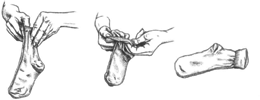
Folding socks, method 3
Napkins. When folding napkins, always fold loosely by hand. Do not iron creases in. A large dinner napkin is folded in a triple screen fold lengthwise, then in another triple screen fold crosswise, producing a square. You can then fold again in half, if you prefer a smaller rectangular shape to a larger square shape or just to save some room on the table. However you fold it, if there is a monogram or corner decoration, it should end up in the lower left-hand corner when the napkin is placed to the left of the forks. (The lower right-hand corner is also fine; just be consistent.)
A smaller dinner napkin is simply folded into a rectangle: in half twice, ending with the monogram or decoration in the lower left corner.
The luncheon napkin and napkins for informal occasions may be folded any way you like—for example, like a dinner napkin, in a triangle, or in a wedge formed from the triangle. To make a wedge, the two points of the triangle are folded to the back in thirds, forming a pentagon with two long sides. The monogram or decoration is in the point, which points downward.

Folding large dinner napkin
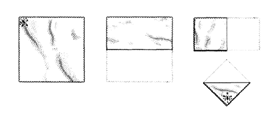
Folding trifold lunch napkin
Tablecloths. Tablecloths should be either rolled around a cardboard tube or loosely folded, so as to avoid creases as much as possible. (One lengthwise crease is acceptable.) You can also hang tablecloths if they are not too wide. Simply fold loosely in half twice, lengthwise, and fold over a hanger with a thick, round bar to avoid causing a crease.
If you wish to fold your tablecloths, large square and rectangular tablecloths may be folded in half three times lengthwise, forming eight layers (the first fold brings wrong sides together), then two or three times crosswise. The number of crosswise and lengthwise folds may be increased or decreased depending on the size of the tablecloth and your drawer space. If you wish the fold lines all to point upward to the right side of the cloth, fold the tablecloth in fourths as follows: Bring each side edge to the middle of the cloth, creating two folds along the sides of the cloth. Then fold again lengthwise along the middle line where the two side edges meet, so that the two edges are inside. Do the same with the crosswise folds.
Fold round tablecloths in half, to form a half-moon shape, with wrong sides together. Then fold in half lengthwise, bringing the arc of the half-moon to the fold. The center of the arc should be even with the center of the fold. Fold lengthwise again if necessary—as for a large cloth. Then fold in half crosswise twice, or three times if the cloth is large. You will have a rectangle. Small round tablecloths are sometimes folded this way: Fold in half twice, forming four layers in the shape of a piece of pie. Then, bringing point to curved edge, fold in half. This makes an irregular shape.
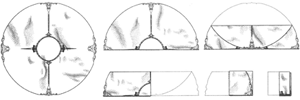
Folding a round tablecloth

Folding a rectangular tablecloth
Blankets. Fold blankets in half, head to foot, twice, then in half, side to side, twice.
Sheets. When folding a flat sheet, hold it with the side facing up that you want to face up when it is on the bed—right side up if it is a bottom sheet and wrong side up if it is a top flat. Fold in half crosswise three times, on the first time bringing right sides together—hem to hem, fold to hem, and fold to hem again, always folding in the same direction. Then fold in half lengthwise three times—selvage to selvage, fold to selvage, fold to selvage again, always folding in the same direction. (“Selvage” is defined in the Glossary of Fabric Terms, page 306. See also chapter 15, page 199.)
To fold a fitted sheet, have the wrong side of the center of the sheet and the right side of the fitted corners facing you. Fold the sheet in half crosswise, tucking the top fitted corners into the bottom fitted corners. Fold in half lengthwise, so that all the fitted corners are in a stack. Now simply fold the sheet in half three more times—once along the length and twice crosswise. This makes a neatly folded fitted sheet of approximately the same size as the folded flat sheet.

Fold two times crosswise

Folding a fitted sheet

Folding a flat sheet:fold to hem two times;fold to selvage two times
Fold both the duvet (comforter) and the druve cover into halves and then querters. Insert the folded duvet into the top quarter of the folded cover so that the duvet’s end the opening of the duvet cover are aligned. Pick up both at the opening, hold tightly, and shake until the cover duvet falls to fill the entire cover.
Pillowcases (Standard, Queen, and King). Fold in thirds lengthwise, then in half crosswise once or twice depending upon your shelf or drawer space. Or reverse this, folding in half crosswise twice, then three times lengthwise. Either way will prettily display trim or lace at the opening of the pillowcase.
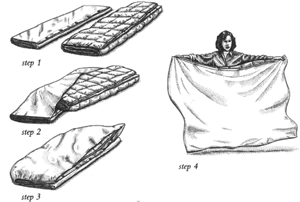
Filling a duvet cover
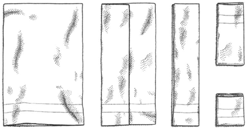
Folding a standard pillowcase
Folded article in suitcase, on shelves, or in drawers resits wrinkling better if you cover them with tissue paper before folding so that the papers is folded up with the garments. You can also stuff puffy sleeves and hats with crumpled tissue paper—enough to gently fill them. When you are putying thigs into long-term storage, espcially antiques, heirlooms, or other precious fabrics, use acid-free tissue paper.
Pillowcases (European).Try folding these in thirds along both dimensions.
Towels. Dish towels, tea towels, bath towels, and hand or guest towels can be folded in thirds lengthwise, then folded in half or thirds crosswise, depending upon the size of the towel and its thickness. Thinner towels are more easily folded many times. This method shows trim nicely and lets you hang the towels with their vertical folds in place; you need not refold for hanging.
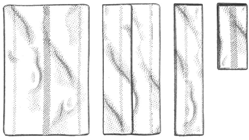
Folding a dish towel
Handkerchiefs. Fold men’s handkerchiefs in half three times, forming rectangles. Fold women’s handkerchiefs twice, forming squares.